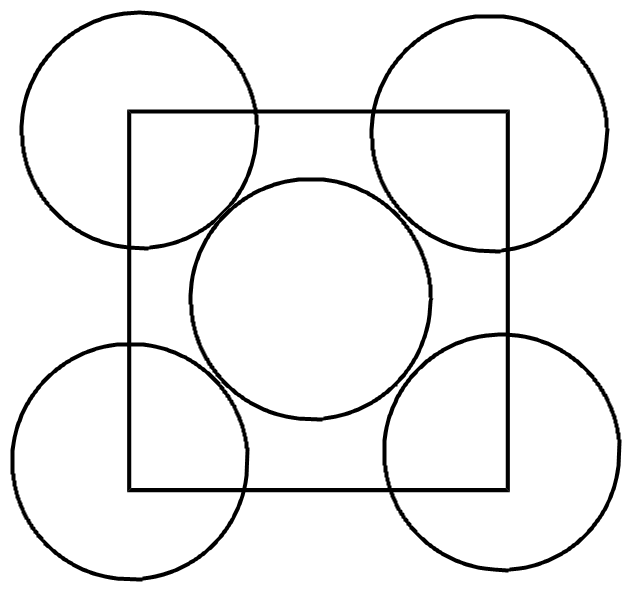
Metal M of radius 50nm is crystallized fcc type and made of cubic crystal such that the face of unit cells is aligned with the face of cubic crystal. If the total number of metal atoms of M at all faces of cubic crystal is $6X{{10}^{30}}$ , then the area of one face of cubic crystal is $AX{{10}^{16}}{{m}^{2}}.$find the value of A.
Answer
582k+ views
Hint: A face centered cubic (FCC) unit cell contains atoms at all the corners and at the centre of all the faces of the cube. Each atom in a face -centered cubic located at the face-centre is shared between two adjacent unit cells and only \[\dfrac{1}{2}\] of each atom belongs to a unit cell.
Complete step by step answer:
Let us consider one face of unit cell,

No of atoms on one face= $4(corners)X\dfrac{1}{8}+1(facecentre)X\dfrac{1}{2}(facecentreshare)=\dfrac{1}{2}+\dfrac{1}{2}=1$ per face
No of metal atoms of M at all metal faces of cubic crystal = $6X{{10}^{30}}$
Therefore, number of atoms on once face =$6X{{10}^{30}}X\dfrac{1}{6}={{10}^{30}} atoms$
Hence number of unit cells at one face of crystal = ${{10}^{30}}$ atoms
So the number of unit cells at the edge of the crystal = $\sqrt{{{10}^{30}}}={{10}^{15}}$
Metal M radius (r) = 50nm
Now, edge length of the unit cell = \[\dfrac{4}{\sqrt{2}}Xr=\dfrac{4}{\sqrt{2}}X50nm\]
Edge length of cubic crystal = \[\dfrac{4}{\sqrt{2}}X50X{{10}^{15}}nm\]
So, area of face crystal = $\begin{align}
& ={{(edge\text{ }length\text{ }of\text{ }cubic\text{ }crystal)}^{2}}={{(\dfrac{4}{\sqrt{2}}X50X{{10}^{15}})}^{2}}n{{m}^{2}}=\dfrac{16}{2}X50X50X{{10}^{30}}X{{10}^{-18}}{{m}^{2}} \\
& =2X{{10}^{16}}{{m}^{2}} \\
\end{align}$
Therefore, $AX{{10}^{16}}{{m}^{2}}=2X{{10}^{16}}{{m}^{2}}$
Hence , the value of A = 2.
Note: We know that any crystal lattice is made up of very large unit cells and every lattice point as occupied by one constituent particle (atom, molecule or ion). We must consider three types of cubic unit cells and for simplicity assume that the constituent particle is an atom.
Complete step by step answer:
Let us consider one face of unit cell,

No of atoms on one face= $4(corners)X\dfrac{1}{8}+1(facecentre)X\dfrac{1}{2}(facecentreshare)=\dfrac{1}{2}+\dfrac{1}{2}=1$ per face
No of metal atoms of M at all metal faces of cubic crystal = $6X{{10}^{30}}$
Therefore, number of atoms on once face =$6X{{10}^{30}}X\dfrac{1}{6}={{10}^{30}} atoms$
Hence number of unit cells at one face of crystal = ${{10}^{30}}$ atoms
So the number of unit cells at the edge of the crystal = $\sqrt{{{10}^{30}}}={{10}^{15}}$
Metal M radius (r) = 50nm
Now, edge length of the unit cell = \[\dfrac{4}{\sqrt{2}}Xr=\dfrac{4}{\sqrt{2}}X50nm\]
Edge length of cubic crystal = \[\dfrac{4}{\sqrt{2}}X50X{{10}^{15}}nm\]
So, area of face crystal = $\begin{align}
& ={{(edge\text{ }length\text{ }of\text{ }cubic\text{ }crystal)}^{2}}={{(\dfrac{4}{\sqrt{2}}X50X{{10}^{15}})}^{2}}n{{m}^{2}}=\dfrac{16}{2}X50X50X{{10}^{30}}X{{10}^{-18}}{{m}^{2}} \\
& =2X{{10}^{16}}{{m}^{2}} \\
\end{align}$
Therefore, $AX{{10}^{16}}{{m}^{2}}=2X{{10}^{16}}{{m}^{2}}$
Hence , the value of A = 2.
Note: We know that any crystal lattice is made up of very large unit cells and every lattice point as occupied by one constituent particle (atom, molecule or ion). We must consider three types of cubic unit cells and for simplicity assume that the constituent particle is an atom.
Recently Updated Pages
The number of solutions in x in 02pi for which sqrt class 12 maths CBSE

Write any two methods of preparation of phenol Give class 12 chemistry CBSE

Differentiate between action potential and resting class 12 biology CBSE

Two plane mirrors arranged at right angles to each class 12 physics CBSE

Which of the following molecules is are chiral A I class 12 chemistry CBSE

Name different types of neurons and give one function class 12 biology CBSE

Trending doubts
Which are the Top 10 Largest Countries of the World?

What are the major means of transport Explain each class 12 social science CBSE

Draw a labelled sketch of the human eye class 12 physics CBSE

Differentiate between insitu conservation and exsitu class 12 biology CBSE

State the principle of an ac generator and explain class 12 physics CBSE

Differentiate between homogeneous and heterogeneous class 12 chemistry CBSE




